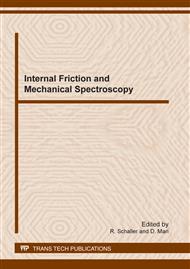[1]
S.B. Fisher, J.E. Harbottle, N. Aldridge, Radiation hardening in magnox pressure-vessel steels, Phil. Trans. R. Soc. Lond. A 315 (1962) 301.
DOI: 10.1098/rsta.1985.0042
Google Scholar
[2]
G.R. Odette, On the dominat mechanism of irradiaition embrittlement of reactor pressure vessel steels, Scr. Metall. 17 (1983) 1183.
DOI: 10.1016/0036-9748(83)90280-6
Google Scholar
[3]
K. C. Russel, L. M. Brown, A dispersion stengthening model based on differing elastic moduli applied to the iron-copper system, Acta Metall. 20 (1972) 969.
DOI: 10.1016/0001-6160(72)90091-0
Google Scholar
[4]
W. J. Phythian, A. J. E. Foreman, C. A. English, J. T. Buswell, M. Hetherington, K. Roberts, S. Pizzini, The Structure and Hardening Mechanism of Copper Precipitation in Thermally Aged or Irradiated Fe-Cu and Fe-Cu-Ni Model Alloys, Eff. Rad. Mat., 15th Intern. Symp., ASTM STP 1125, American Society for Testing and Materials, Philadephia, 1992, p.131.
DOI: 10.1520/stp17866s
Google Scholar
[5]
P. Haasen, Physical Metallurgy, third ed., Cambridge, (1996).
Google Scholar
[6]
M.J. Konstantinović, Internal friction study of dislocation dynamics in neutron irradiated iron, and iron–copper alloys, J. Nucl. Mater. 395 (2009) 75.
DOI: 10.1016/j.jnucmat.2009.09.020
Google Scholar
[7]
H. Ogi, H. Ledbetter, S. Kim, Snoek relaxation and dislocation damping in aged Fe-Cu-Ni steel, Metall. Mater. Trans. A 32 (2001) 1671.
DOI: 10.1007/s11661-001-0145-3
Google Scholar
[8]
F. Walz, F. Walz, M. Weller and M. Hircher, Magnetic after-effect and internal friction as quantitative tools for the analysis of carbon and nytrogen in α-Fe, Phys. Stat. Sol (a) 154 (1996) 765.
DOI: 10.1002/pssa.2211540230
Google Scholar
[9]
B. Minov, L. Dupré, M.J. Konstantinović, Magnetic after-effect study of dislocation relaxation in Fe-based alloys, J. Phys. D: Appl. Phys 44 (2011) 305002.
DOI: 10.1088/0022-3727/44/30/305002
Google Scholar
[10]
M. Konstantinović, Tensile properties and internal friction study of dislocation movement in Fe-Cu system as a function of Cu-precipitation, J. Nucl. Mater. 362 (2007) 283.
DOI: 10.1016/j.jnucmat.2007.01.226
Google Scholar
[11]
Y. Kamada, Y. Nishino, S. Hosoi, S. Tamaoka, N. Ide, H. Kikuchi, S. Kobayashi, Internal friction and magnetic properties of thermally aged Fe-1 wt. % Cu alloys, Mat. Sci. Eng. A 521-22 (2009) 209.
DOI: 10.1016/j.msea.2008.09.143
Google Scholar
[12]
R. De Batist, Internal Friction of Structural Defects in Crystalline Solids, North Holland – American Elsevier (1972).
Google Scholar
[13]
B. Minov, L. Vandenbossche, M. J. Konstantinović, L. Dupré, Magnetic after-effect study of the Cu-precipitation in thermally aged Fe-1%Cu alloys, IEEE Trans. Magn., 46 (2010) 521.
DOI: 10.1109/tmag.2009.2033943
Google Scholar
[14]
J. L. Snoek, Physica, Elsevier 8 (1941)711.
Google Scholar
[15]
Y. Wang, M. Gu, L. Sun, K. L. Ngai, Mechanism of Snoek-Köster relaxation in body-centered-cubic metals, Phys. Rev. B 50, (1994) 3525.
DOI: 10.1103/physrevb.50.3525
Google Scholar
[16]
M.S. Blanter, I.S. Golovin, H. Neuhäuser, and H. -R. Sinning, Internal friction in metallic materials – A handbook, Springer, (2007).
DOI: 10.1007/978-3-540-68758-0
Google Scholar
[17]
L.B. Magalas, Snoek-Köster relaxation. New insights - New paradigms, J. Physique IV 6 C-8 (1996) 163.
DOI: 10.1051/jp4:1996834
Google Scholar
[18]
K. Van Ouytsel, R. De Batist, R. Schaller, An internal friction working model to advance the understanding of effects of radiation and thermal ageing on reactor pressure-vessel steels, J. Press. Vess. Pip. 80 (2003) 275.
DOI: 10.1016/s0308-0161(03)00045-0
Google Scholar
[19]
H. Mizubayashi, H. Kronmüller, A. Seeger, The gamma-peak in deformed high purity α-Fe studied by forced vibrations out of resonance, J. Physique 46 C-10 (1985) 309.
DOI: 10.1051/jphyscol:19851069
Google Scholar
[20]
G. Fantozzi, C. Esnouf, W. Benoit, I.G. Ritchie, Internal friction and microdeformation due to the intrinsic-properties of dislocations-the Bordoni relaxation, Prog. Mat. Sci. 27 (1982) 311.
DOI: 10.1016/0079-6425(82)90003-2
Google Scholar
[21]
I.G. Ritchie, J. Dufresne, P. Moser, The internal-friction peaks –alpha and beta-1 in irradiated or deformed pure iron, Phys. Stat. Sol. A 61 (1980) 591.
DOI: 10.1002/pssa.2210610233
Google Scholar
[22]
L.B. Magalas, P. Moser, I.G. Ritchie, The dislocation-enhanced Snoek-peak in Fe-C alloys, J. Phys. 44 (1983) C9-645.
DOI: 10.1051/jphyscol:1983997
Google Scholar
[23]
F. Walz, H. J. Blythe, H. Kronmüller, Magnetic relaxation occuring in low-temperature electron-irradiated α-Fe after annealing above stage III (220 K), Phys. Stat. Sol. (a), 61 (1980) 607.
DOI: 10.1002/pssa.2210610235
Google Scholar


